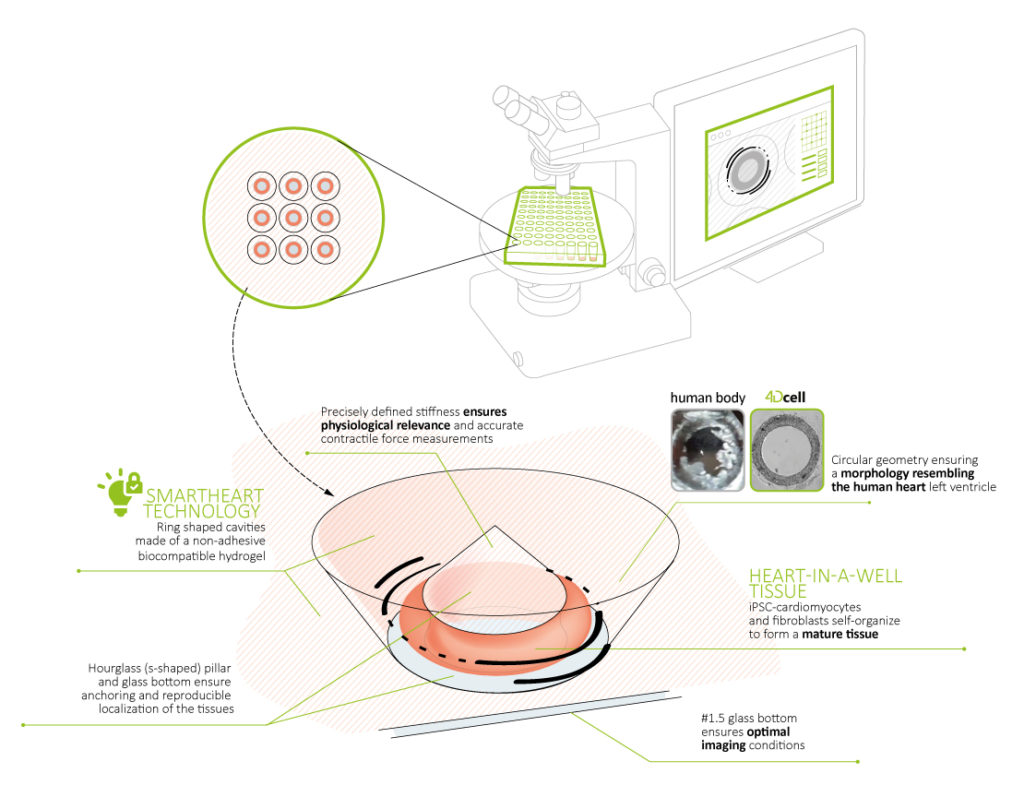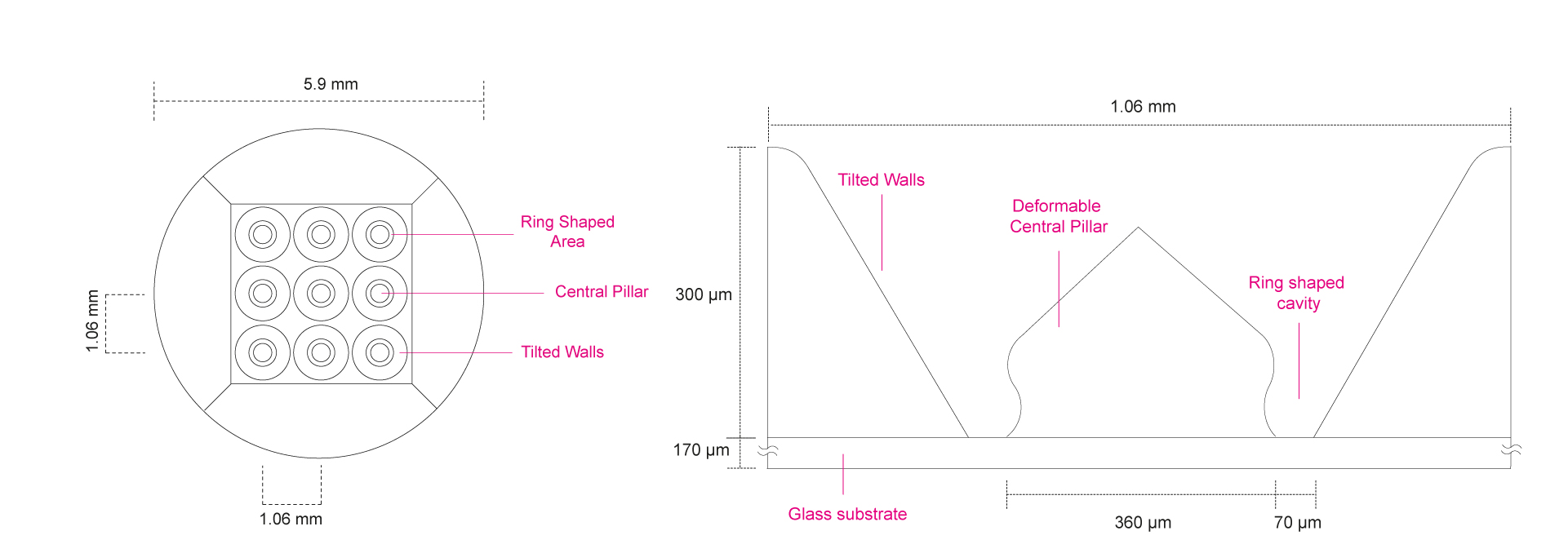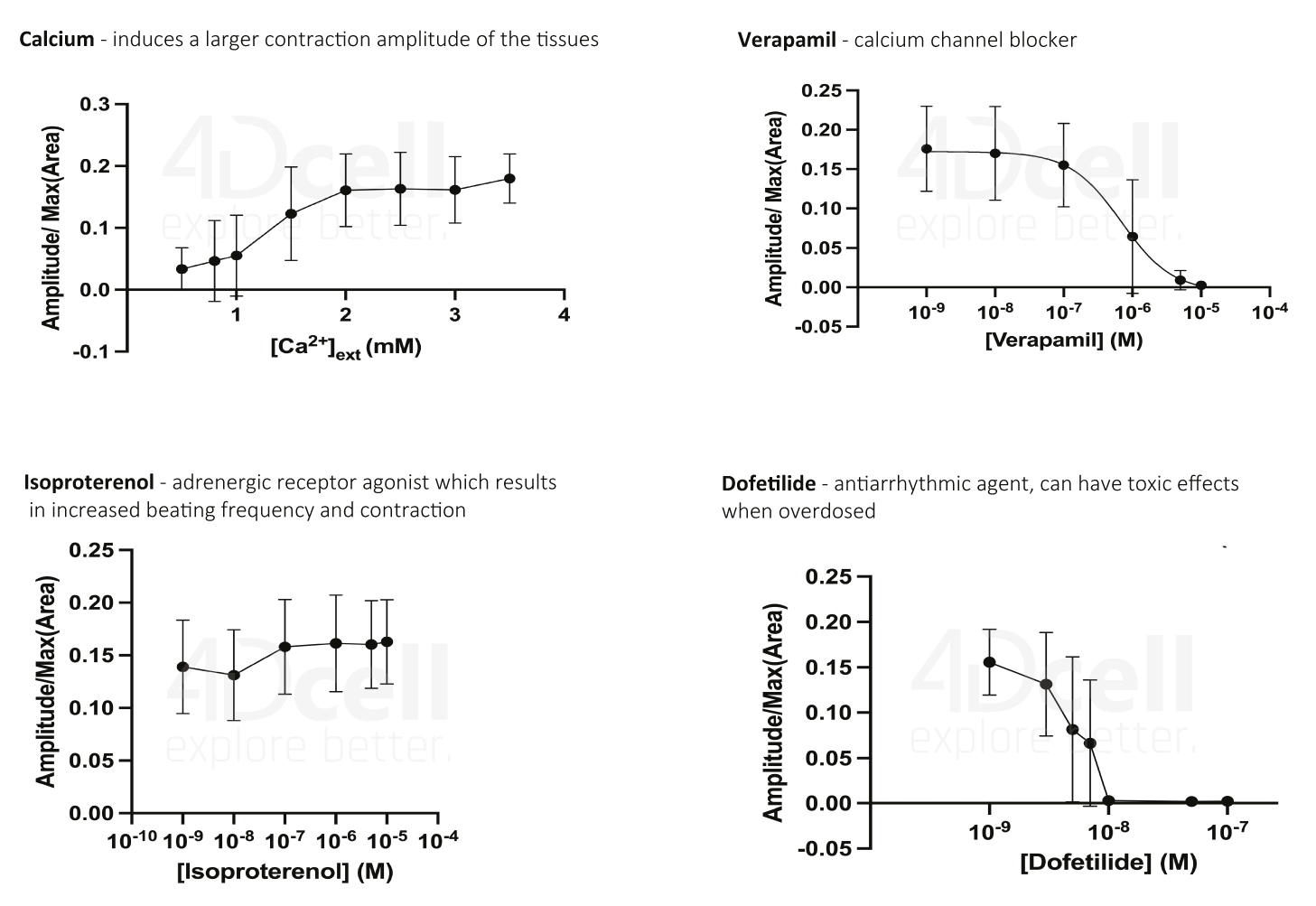SmartHeart: Cardiac Contractility Assay
Achieve a breakthrough number of readouts in a single assay
Achieve a breakthrough number of readouts in a single assay
PLATE YOUR CELLS. LET THEM BEAT. MEASURE.

The SmartHeart is a 3D cardiac assay, which enables both the self-assembly and maturation of functional cardiac organoids based on cardiomyocytes derived from hiPSC and human fibroblast cells as well as the acquisition of relevant read-outs, all in a single platform. The hydrogel is optically transparent enabling high resolution imaging of the tissues as well as to observe ionic exchanges through optical mapping.
The hydrogel shape provides a microenvironment which enables the cells to sediment and aggregate into a beating ring within hours. It can be used to test new compounds or assess toxicity of drugs targeting other types of pathologies, as it can be simply scaled to fit HTS and HCS requirements.
Plate your cells directly on the microstructured plates
The specific shape allows an improved maturation of the tissues while enabling a wide range of tests
Quantify contractility stress and strain, beating frequency and beating amplitude, contraction velocity and ionic exchange. Observe tissue morphology, and intracellular organization. Etc.
Tissues are located in predictable positions enabling automated image acquisition (bright field, fluorescence, phase contrast, etc.)
Control the substrate stiffness mimicking the in vivo environment of your cell type (5 kPa to 20 kPa)
The SmartHeart was developed in collaboration with the team of Pr. Jean Sébastien HULOT, Heart Failure Translational Research Lab, INSERM U970 |
Paris Cardiovascular Research Center – PARCC (Hôpital Européen Georges Pompidou).
See the related publication: A versatile high-throughput assay based on 3D ring-shaped cardiac tissues generated from human induced pluripotent stem cell derived cardiomyocytes
Immunofluorescence imaging of the tissues after 14 days. Z-scan using confocal microscopy. Fibroblasts are added to provide stability to the tissues, by forming a structural layer below the iPSC-CMs.

Data from Seguret et al. eLife 12:RP87739 (2023).
FEATURES & BENEFITS
The contractility based parameters are assessed through the deformation of the central pillar, as the mechanical properties of the hydrogel are known and can be adjusted to match the cell model.

Scheme of the working principle of the structured hydrogel responsible for the formation of the ring-shaped organoids.
> The cell culture substrate is based on a biocompatible Polyethylene glycol (PEG) hydrogel with molded microwells containing a central pillar.
> The hydrogel is cell repellent, precluding the adhesion of cells to the substrate.
> The inclined walls (funnel shape) of the microwells allow the cells to be guided towards the circular cavity, thus decreasing the number of cells lost in the seeding process.
> The ring shaped organoids are kept in place during medium exchange, addition of drugs, etc. This is achieved because the bottom of the microwells are made of glass, enabling the organoid to anchor to this area. In addition, the central pillar has an ‘s’ shape profile, preventing the rings from sliding up due to contractions.
> The soft nature of the hydrogel (5 kPa to 20 kPa) enables the quantification of the contractility force through the deformation of the central pillar.
> The gel stiffness can be tuned according to the cell model in place.
> The cell culture substrates are compatible with image acquisition, as the cells are seeded on areas composed of only glass, the PEG hydrogel surrounding the cells is transparent and #1.5 glass (ideal for most objectives) is used.
> Cells used are cardiomyocytes derived from hiPSC and fibroblasts.
The ring shaped cavities for cell culture are molded on biocompatible hydrogels (polyethylene glycol- PEG), using molds fabricated by high-resolution milling.

The assessment of the contractility-based read-outs should be performed using the software developed by 4Dcell, which is accessible here.
Videos of the contracting ring-shaped tissues can be recorded using normal bright field microscopy. The frame rate should be of at least 30 fps and the resolution should be higher than 500 x 500 pixels.
From the analysis of this kind of videos the following parameters are determined by the software:

Data from Seguret et al. eLife 12:RP87739 (2023).

Data from Seguret et al. eLife 12:RP87739 (2023).
24 and 96 well plates with glass bottom ( #1.5, 0.16 – 0.19 mm)
Each well has 21 (for 24 well plate) and 9 (for 96 well plate) individual microwells for tissue formation
The gels are provided in an aqueous solution that retains their mechanical and optical properties
DRUG DISCOVERY
> Muscle atrophy
> Metabolism
DISEASE MODELS
> Muscular diseases
> Neuromuscular disorders
> Metabolic disorders
> Muscle fibrosis
CARDIOTOXICITY